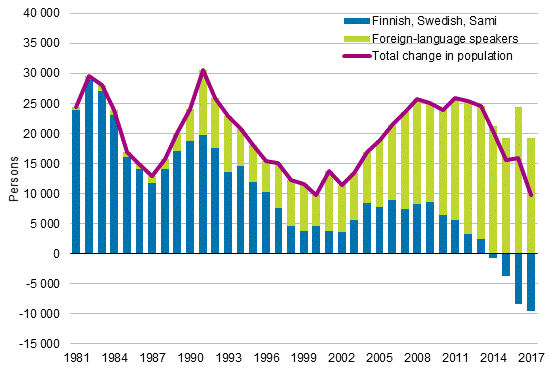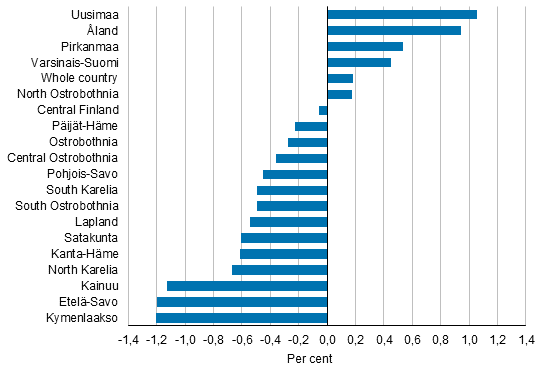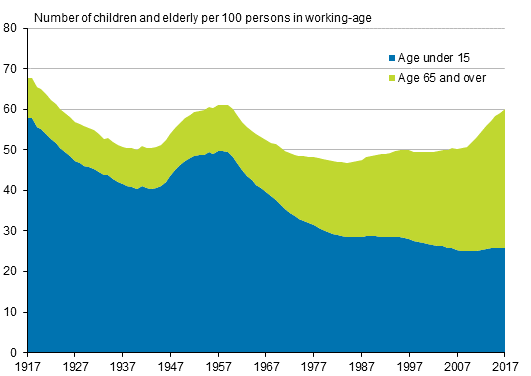Published: 29 March 2018
Decrease in the number of persons speaking national languages as their native language accelerated
According to Statistics Finland's statistics on population structure, the official total population of Finland at the end of 2017 was 5,513,130. In the course of 2017, Finland’s population grew by 9,833 persons. Population growth was smallest since 2000. The number of persons speaking Finnish, Swedish or Sami as their native language went down by 9,499 persons. The number of foreign-language speakers grew by 19,332 persons.
Change in the population by native language in 1981 to 2017

Population of Kanta-Häme and Kymenlaakso decreased most in almost 50 years
During 2017, the population grew in in five regions and diminished in 14 regions. In absolute numbers, the population grew most in Uusimaa, by 17,331 persons, in Pirkanmaa, by 2,725 persons, and in Varsinais-Suomi, by 2,134 persons. The relative population increase was also highest in Uusimaa 1.1 per cent.
In absolute numbers, the population decreased most in Kymenlaakso, by 2,148 persons, and in Etelä-Savo, by 1,781 persons. In relative numbers, the population also decreased most in Kymenlaakso and Etelä-Savo (by 1.2 per cent). In the regions of Kanta-Häme and Kymenlaakso the population decreased most in absolute numbers in almost 50 years.
Population change by region 2017

Kouvola’s population decreased by over 1,100 persons
During 2017, the population grew in 77 municipalities and diminished in 232 municipalities. The biggest absolute increase in population was seen in Helsinki, 8,091 persons, Espoo, 4,461 persons and Vantaa, 3,686 persons, Foreign-language speakers accounted for two-thirds of the population growth in the Helsinki region.
Examined by municipality in Mainland Finland, Järvenpää (2.5 per cent), Kauniainen (2.4 per cent) and Uusikaupunki (2.3 per cent) had the largest relative increases in population. In absolute numbers, the population decreased most in Kouvola, by 1,110 persons, and in Kotka, by 648 persons. In Mainland Finland, the largest relative decreases in population occurred in Halsua (3.9 per cent), Kaavi (3.4 per cent), and Posio (3.3 per cent).
Share of foreign-language speakers seven per cent of the total population, nearly one-fifth in Vantaa
A total of 373,325 persons speaking a foreign language as their native language were living permanently in Finland at the end of 2017. The proportion of foreign-language speakers in the total population was now seven per cent. The biggest foreign-language speaking groups were Russian speakers, 77,177 persons, Estonian speakers, 49,590, and Arabic speakers, 26,467.
Examined by region, the share of foreign-language speakers was at the end of 2017 highest in the region of Uusimaa, 13 per cent of the population, and the lowest in South Ostrobothnia, two per cent. Examined by municipality, the share of foreign-language speakers among the population was highest in Vantaa, 18 per cent, in Espoo, 16 per cent, and Helsinki, 15 per cent.
Demographic dependency ratio highest in Etelä-Savo, lowest in Uusimaa
At the end of 2017, there were 890,424 persons aged under 15 in Finland and 3,443,388 persons aged between 15 and 64. Persons aged 65 or over numbered 1,179,318 at the end of 2017. The demographic dependency ratio, that is, the number of those aged 15 or under and 65 or over per 100 working age persons, was 60.1. The demographic dependency ratio was last higher than this in 1959. During our independence, the demographic dependency ratio was at its highest in 1917 (67.6) and at its lowest in 1984 (46.7).
Examined by area, the demographic dependency ratio was highest in the regions of Etelä-Savo, 72.8 and Central Ostrobothnia, 70.1. The demographic dependency ratio was lowest in the region of Uusimaa, 51.1. Examined by municipality, the demographic dependency ration was highest in Luhanka, 104.5, and Kuhmoinen, 102.7, and lowest in Helsinki, 45.2, and Tampere, 48.2.
Demographic dependency ratio in 1917–2017

Source: Population Structure 2017, Statistics Finland
Inquiries: Markus Rapo 029 551 3238, info@stat.fi
Director in charge: Jari Tarkoma
Publication in pdf-format (359.5 kB)
- Tables
-
Tables in databases
Pick the data you need into tables, view the data as graphs, or download the data for your use.
Appendix tables
- Appendix table 1. Regional adjustments 1.1.2018 (29.3.2018)
- Appendix table 2. Population according to language by region 1997 to 2017 (29.3.2018)
- Appendix table 3. The demographic dependency ratio by region 1997 - 2017 (29.3.2018)
- Appendix table 4. Finnish citizens with dual nationality by region 2002 - 2017 (29.3.2018)
- Figures
- Quality descriptions
-
- Quality description: Population structure 2017 (29.3.2018)
Updated 29.03.2018
Official Statistics of Finland (OSF):
Population structure [e-publication].
ISSN=1797-5395. 2017. Helsinki: Statistics Finland [referred: 11.1.2026].
Access method: http://stat.fi/til/vaerak/2017/vaerak_2017_2018-03-29_tie_001_en.html

